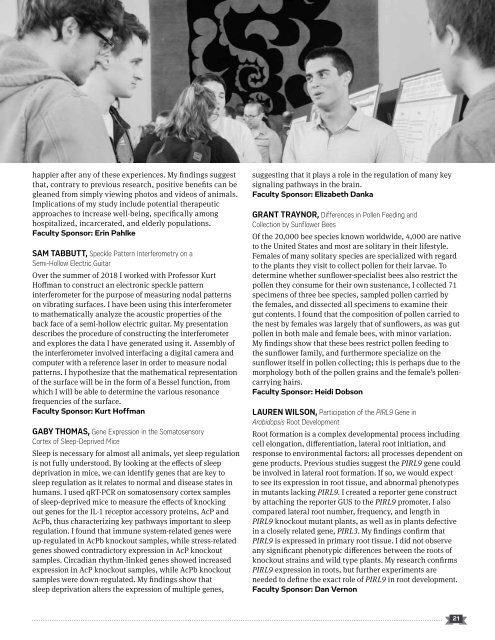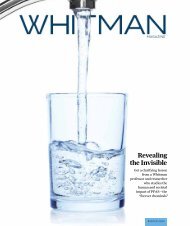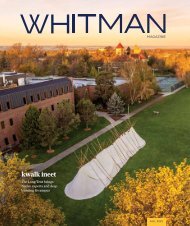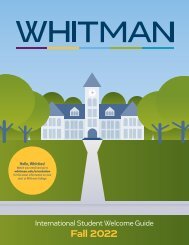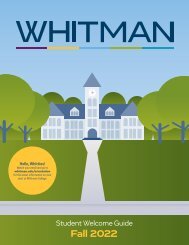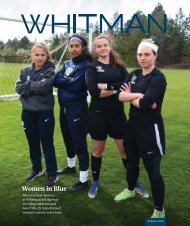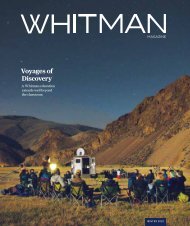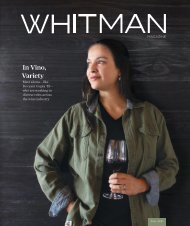You also want an ePaper? Increase the reach of your titles
YUMPU automatically turns print PDFs into web optimized ePapers that Google loves.
happier after any of these experiences. My findings suggest<br />
that, contrary to previous research, positive benefits can be<br />
gleaned from simply viewing photos and videos of animals.<br />
Implications of my study include potential therapeutic<br />
approaches to increase well-being, specifically among<br />
hospitalized, incarcerated, and elderly populations.<br />
Faculty Sponsor: Erin Pahlke<br />
SAM TABBUTT, Speckle Pattern Interferometry on a<br />
Semi-Hollow Electric Guitar<br />
Over the summer of 2018 I worked with Professor Kurt<br />
Hoffman to construct an electronic speckle pattern<br />
interferometer for the purpose of measuring nodal patterns<br />
on vibrating surfaces. I have been using this interferometer<br />
to mathematically analyze the acoustic properties of the<br />
back face of a semi-hollow electric guitar. My presentation<br />
describes the procedure of constructing the interferometer<br />
and explores the data I have generated using it. Assembly of<br />
the interferometer involved interfacing a digital camera and<br />
computer with a reference laser in order to measure nodal<br />
patterns. I hypothesize that the mathematical representation<br />
of the surface will be in the form of a Bessel function, from<br />
which I will be able to determine the various resonance<br />
frequencies of the surface.<br />
Faculty Sponsor: Kurt Hoffman<br />
GABY THOMAS, Gene Expression in the Somatosensory<br />
Cortex of Sleep-Deprived Mice<br />
Sleep is necessary for almost all animals, yet sleep regulation<br />
is not fully understood. By looking at the effects of sleep<br />
deprivation in mice, we can identify genes that are key to<br />
sleep regulation as it relates to normal and disease states in<br />
humans. I used qRT-PCR on somatosensory cortex samples<br />
of sleep-deprived mice to measure the effects of knocking<br />
out genes for the IL-1 receptor accessory proteins, AcP and<br />
AcPb, thus characterizing key pathways important to sleep<br />
regulation. I found that immune system-related genes were<br />
up-regulated in AcPb knockout samples, while stress-related<br />
genes showed contradictory expression in AcP knockout<br />
samples. Circadian rhythm-linked genes showed increased<br />
expression in AcP knockout samples, while AcPb knockout<br />
samples were down-regulated. My findings show that<br />
sleep deprivation alters the expression of multiple genes,<br />
suggesting that it plays a role in the regulation of many key<br />
signaling pathways in the brain.<br />
Faculty Sponsor: Elizabeth Danka<br />
GRANT TRAYNOR, Differences in Pollen Feeding and<br />
Collection by Sunflower Bees<br />
Of the 20,000 bee species known worldwide, 4,000 are native<br />
to the United States and most are solitary in their lifestyle.<br />
Females of many solitary species are specialized with regard<br />
to the plants they visit to collect pollen for their larvae. To<br />
determine whether sunflower-specialist bees also restrict the<br />
pollen they consume for their own sustenance, I collected 71<br />
specimens of three bee species, sampled pollen carried by<br />
the females, and dissected all specimens to examine their<br />
gut contents. I found that the composition of pollen carried to<br />
the nest by females was largely that of sunflowers, as was gut<br />
pollen in both male and female bees, with minor variation.<br />
My findings show that these bees restrict pollen feeding to<br />
the sunflower family, and furthermore specialize on the<br />
sunflower itself in pollen collecting; this is perhaps due to the<br />
morphology both of the pollen grains and the female’s pollencarrying<br />
hairs.<br />
Faculty Sponsor: Heidi Dobson<br />
LAUREN WILSON, Participation of the PIRL9 Gene in<br />
Arabidopsis Root Development<br />
Root formation is a complex developmental process including<br />
cell elongation, differentiation, lateral root initiation, and<br />
response to environmental factors: all processes dependent on<br />
gene products. Previous studies suggest the PIRL9 gene could<br />
be involved in lateral root formation. If so, we would expect<br />
to see its expression in root tissue, and abnormal phenotypes<br />
in mutants lacking PIRL9. I created a reporter gene construct<br />
by attaching the reporter GUS to the PIRL9 promoter. I also<br />
compared lateral root number, frequency, and length in<br />
PIRL9 knockout mutant plants, as well as in plants defective<br />
in a closely related gene, PIRL3. My findings confirm that<br />
PIRL9 is expressed in primary root tissue. I did not observe<br />
any significant phenotypic differences between the roots of<br />
knockout strains and wild type plants. My research confirms<br />
PIRL9 expression in roots, but further experiments are<br />
needed to define the exact role of PIRL9 in root development.<br />
Faculty Sponsor: Dan Vernon<br />
21


